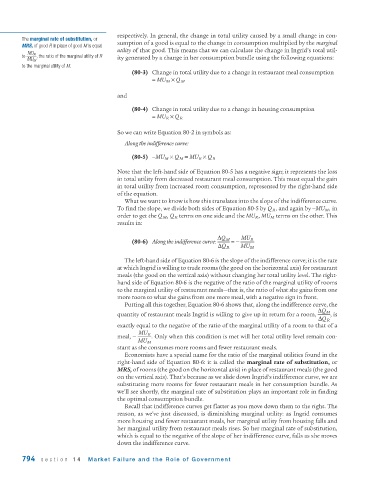Page 836 - Krugmans Economics for AP Text Book_Neat
P. 836
respectively. In general, the change in total utility caused by a small change in con-
The marginal rate of substitution, or
sumption of a good is equal to the change in consumption multiplied by the marginal
MRS, of good R in place of good M is equal
utility of that good. This means that we can calculate the change in Ingrid’s total util-
to MU R , the ratio of the marginal utility of R ity generated by a change in her consumption bundle using the following equations:
MU M
to the marginal utility of M.
(80-3) Change in total utility due to a change in restaurant meal consumption
= MU M × Q M
and
(80-4) Change in total utility due to a change in housing consumption
= MU R × Q R
So we can write Equation 80-2 in symbols as:
Along the indifference curve:
(80-5) −MU M × Q M = MU R × Q R
Note that the left-hand side of Equation 80-5 has a negative sign; it represents the loss
in total utility from decreased restaurant meal consumption. This must equal the gain
in total utility from increased room consumption, represented by the right-hand side
of the equation.
What we want to know is how this translates into the slope of the indifference curve.
To find the slope, we divide both sides of Equation 80-5 by Q R , and again by −MU M , in
order to get the Q M , Q R terms on one side and the MU R , MU M terms on the other. This
results in:
ΔQ M MU R
(80-6) Along the indifference curve: = −
ΔQ R MU M
The left-hand side of Equation 80-6 is the slope of the indifference curve; it is the rate
at which Ingrid is willing to trade rooms (the good on the horizontal axis) for restaurant
meals (the good on the vertical axis) without changing her total utility level. The right-
hand side of Equation 80-6 is the negative of the ratio of the marginal utility of rooms
to the marginal utility of restaurant meals—that is, the ratio of what she gains from one
more room to what she gains from one more meal, with a negative sign in front.
Putting all this together, Equation 80-6 shows that, along the indifference curve, the
ΔQ M
quantity of restaurant meals Ingrid is willing to give up in return for a room, , is
ΔQ R
exactly equal to the negative of the ratio of the marginal utility of a room to that of a
meal, − MU R . Only when this condition is met will her total utility level remain con-
MU M
stant as she consumes more rooms and fewer restaurant meals.
Economists have a special name for the ratio of the marginal utilities found in the
right-hand side of Equation 80-6: it is called the marginal rate of substitution, or
MRS, of rooms (the good on the horizontal axis) in place of restaurant meals (the good
on the vertical axis). That’s because as we slide down Ingrid’s indifference curve, we are
substituting more rooms for fewer restaurant meals in her consumption bundle. As
we’ll see shortly, the marginal rate of substitution plays an important role in finding
the optimal consumption bundle.
Recall that indifference curves get flatter as you move down them to the right. The
reason, as we’ve just discussed, is diminishing marginal utility: as Ingrid consumes
more housing and fewer restaurant meals, her marginal utility from housing falls and
her marginal utility from restaurant meals rises. So her marginal rate of substitution,
which is equal to the negative of the slope of her indifference curve, falls as she moves
down the indifference curve.
794 section 14 Market Failure and the Role of Gover nment

